Chicken, a staple of many diets, provides a healthy and flavorful source of protein. However, because it is susceptible to bacterial contamination, ensuring proper preparation, storage, and cooking of chicken is important to avoid foodborne illnesses. Although frozen chicken can extend its shelf life from a few days to about a year, refrigeration is a more immediate storage option that many people choose due to its convenience. However, the question “How long can it stay in your refrigerator” often comes up. This Essential24 guide aims to clarify how long does chicken last in the fridge, including detailed insights on specific types like how long does rotisserie chicken last in the fridge, ensuring safety and freshness.
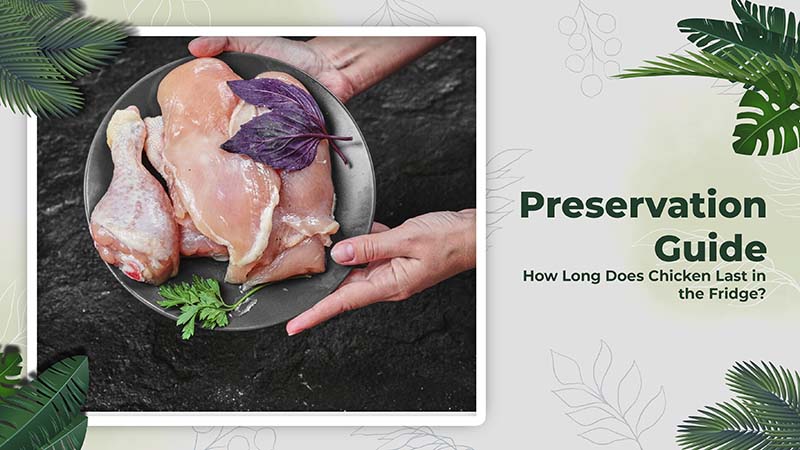
1. How Long Can Raw Chicken Be Stored in the Fridge?
Raw chicken is extremely susceptible to spoilage, even when stored in the refrigerator. According to FoodSafety.gov, it’s advisable to keep raw chicken in the fridge for a maximum of one to two days. Although there might be a “best if used by” date on the packaging, you should consume it within a day or two, regardless of whether the printed expiration date has elapsed.
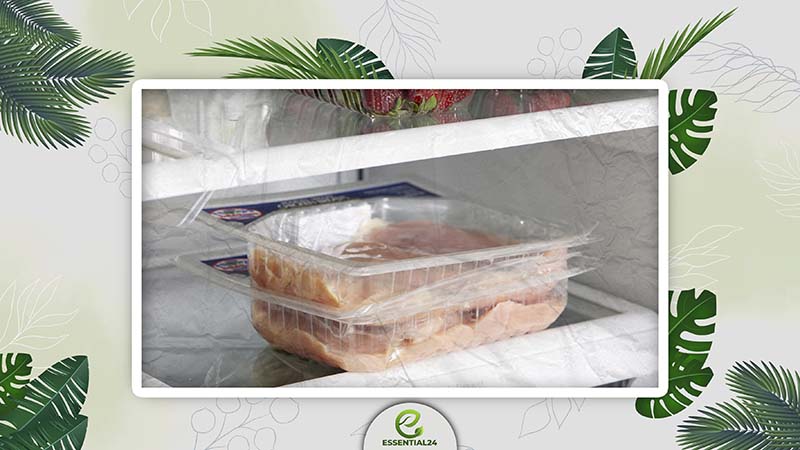
Upon purchasing raw chicken from the supermarket, it’s best to plan your meals accordingly, aiming to cook it either on the day of purchase or the following day. This guideline applies to various forms of raw chicken, including whole chicken and different cuts such as breast, thighs, and drumsticks, as well as raw turkey.
If you find yourself with refrigerated raw chicken beyond the two-day mark, it’s prudent to assess its condition. At this point, the USDA recommends erring on the side of caution and discarding the chicken to prevent any potential risks associated with spoilage.
2. Signs That Indicate Spoilage in Raw Chicken
If you’re asking ‘how long does chicken last in the fridge?’, it’s crucial to recognize the signs of spoilage in raw chicken that’s no longer safe to consume. Here are some indicators to watch out for:
- Odor: Trust your nose. Spoiled chicken emits a foul smell that’s distinctly unpleasant.
- Appearance: Take a good look at the meat. Spoiled raw chicken often appears excessively shiny and slimy.
- Color: Pay attention to the color. Spoiled chicken tends to lose its typical pinkish hue and may display shades of gray, green, or yellow. Mold growth may also be visible on the flesh in some cases.
- Texture: Feel the texture of the meat. Spoiled chicken may feel unusually stiff when pressure is applied, leaving an indentation that doesn’t spring back. Conversely, it may also feel soft and slimy.
Remember, always prioritize food safety. After handling raw chicken, ensure to wash your hands thoroughly with warm, soapy water for at least 20 seconds to minimize the risk of contamination.
3. Understanding the Dates on the Packaging
When decoding dates on food packaging, we need to clearly understand their meaning. Here’s a breakdown of the different types of dates you might encounter:
- Packed On (Pack Date): This indicates the date of manufacturing, processing, or final packing. While not typically intended for consumers, the pack date is crucial for manufacturers and retailers to manage inventory, rotate items, and facilitate recall procedures.
- Sell By (Pull Date): This is the last date by which the food should be sold. However, if stored properly, the food remains safe for consumption for several days beyond the sell-by date. Stores are obligated to remove products by this date, but refrigerated items can still be consumed safely at home. Milk, for example, often remains edible for up to a week longer than the sell-by date, while other foods like yogurt or eggs may stay fresh for even longer.
- Used By (Best Quality Date): After this date, the quality of the product begins to decline, although it remains safe to eat. While these foods boast a long shelf life, they eventually start to lose flavor or develop off-flavors. The listed date is an estimate of when the food will be at its peak quality in terms of smell, taste, and texture. Despite a potential decrease in taste post-date, the food remains safe. However, if the product exhibits any unusual smells or tastes, or if the package seal is compromised, it’s best to refrain from using it.
- Exp. Date (Expiration Date): This marks the final date by which the product should be used before experiencing a loss of quality, though it remains safe for consumption. While products may still be safe beyond this date, their utility and quality may diminish. However, certain items like infant formula, baby food, and over-the-counter drugs should never be consumed after their expiration dates due to potential risks. While rising agents like yeast may be safe post-expiration, they might not be as effective.
Understanding these dates can aid in ensuring food safety and maintaining quality in your consumption habits.
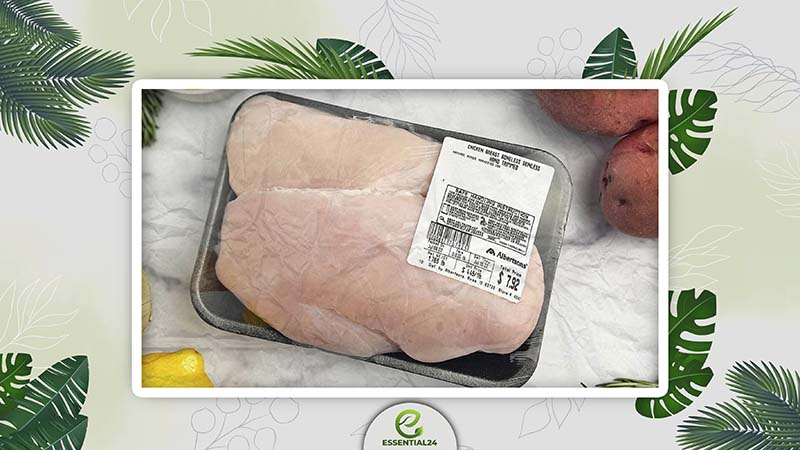
4. Risks Associated with Consuming Spoiled Chicken
Consuming spoiled chicken poses significant risks of foodborne illness, commonly referred to as food poisoning.
Chicken carries a heightened risk of causing food poisoning due to potential contamination with bacteria such as Campylobacter, Salmonella, and others.
Although thorough cooking usually eliminates these bacteria in fresh chicken, you must avoid cooking and eating spoiled chicken. Even if reheated or cooked, some toxins produced by bacteria may persist, leading to food poisoning upon consumption.
Food poisoning manifests through various uncomfortable and sometimes severe symptoms, including:
- High fever (above 101.5°F or 38.6°C)
- Chills
- Nausea
- Vomiting
- Diarrhea
- Bloody stools
- Dehydration
Severe cases of food poisoning may necessitate hospitalization and, in rare instances, can result in fatalities.
Should you suspect that your chicken has spoiled, it’s imperative to refrain from eating it. Discarding any chicken you suspect to be spoiled is always the safest course of action.
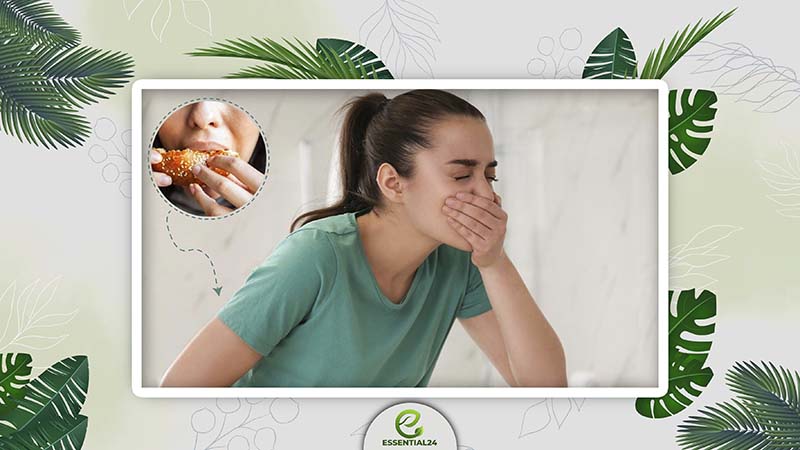
5. Tips for Selecting and Preserving Chicken to Maintain Freshness
Selecting the finest chicken begins with your journey to the supermarket. Opt for chicken that exhibits a light, pink hue, indicating its freshness. To prevent any leakage from contaminating your other purchases, placing the chicken in a separate disposable bag is a wise move.
Discovering how long does chicken last in the fridge begins with selecting and knowing how to optimally store raw chicken in your refrigerator:
Step 1 – Proper Wrapping: First, the chicken must be cleaned. Afterward, seal it within a container to ward off any cross-contamination with other raw items. Wrapping it securely in multiple layers can also prevent the chicken from suffering freezer burn if stored in the freezer, which can alter its taste, color, and moisture content, leading to a less than desirable flavor upon cooking.
Step 2 – Regulate Fridge Temperature: After securing the chicken in wrap, place it in the fridge or freezer neatly. For freezer storage, ensure the temperature is steadfast at -25 degrees Celsius. Regularly monitoring the temperature is crucial to preserving the meat’s quality.
Step 3 – Fridge Organization: The layout of your refrigerator plays a pivotal role in maintaining the chicken’s freshness. Avoid overcrowding; utilizing containers to organize and conserve space can help in evenly distributing the cold air.
Step 4 – Monitor Storage Duration: While it’s possible to keep raw chicken in the freezer for up to 9 months, for optimal taste and nutritional value, it’s advisable to consume it within a month. Keeping track of storage times, labeling, and noting down the date of storage will help prioritize which chicken to use first, ensuring freshness and quality.
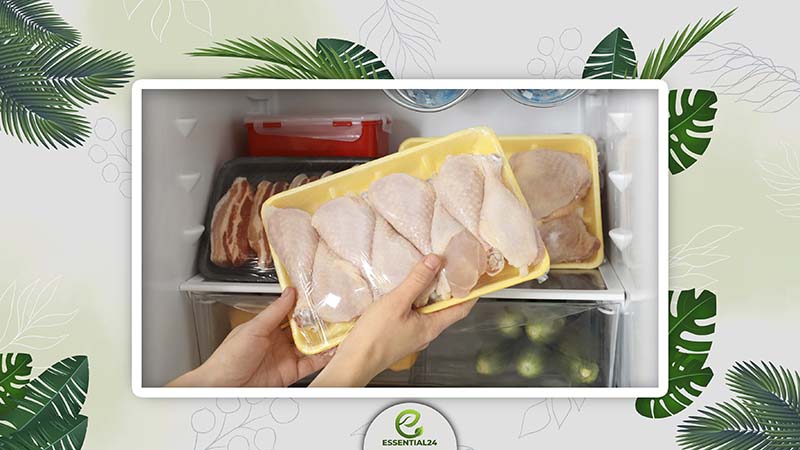
6. Key Takeaways About Storing Chicken in the Fridge
Understanding how long does rotisserie chicken last in the fridge, along with other types, is part of optimizing the storage of chicken in your refrigerator, which involves considering several important factors:
- Storage Duration: Raw chicken can typically be safely stored in the refrigerator for 1-2 days, while cooked chicken can last for about 3-4 days. It’s crucial to adhere to these timelines to minimize the risk of spoilage and foodborne illness.
- Check Expiration Dates: Always check the “best if used by” date on the packaging to gauge the freshness of chicken. Additionally, be vigilant for signs of spoilage such as changes in smell, texture, and color, which can indicate that the chicken has gone bad.
- Avoid Spoiled Chicken: It’s essential to avoid consuming spoiled chicken, even if it has been cooked thoroughly. Cooking may not eliminate all harmful bacteria or toxins that have developed in spoiled chicken, posing a risk of food poisoning.
- Exercise Caution: To mitigate the risk of foodborne illness, it’s recommended to exercise caution and promptly discard any chicken that exhibits signs of spoilage. Prioritizing food safety ensures a healthy and enjoyable dining experience.
- By keeping these key points in mind, you can effectively store chicken in the refrigerator while safeguarding against the potential risks associated with spoiled poultry.
7. Conclusion
In conclusion, master the art of preserving chicken in the refrigerator is a vital skill for any kitchen aficionado, and our exploration of “How Long Does Chicken Last in the Fridge“ has provided invaluable insights to elevate your culinary journey. We encourage you to share your own experiences and tips for preserving chicken freshness in the comments below. And remember, this is just the beginning of your culinary adventure with Essential24. Be sure to check out more of our blogs for further inspiration and expertise on all things food-related. Happy cooking!


